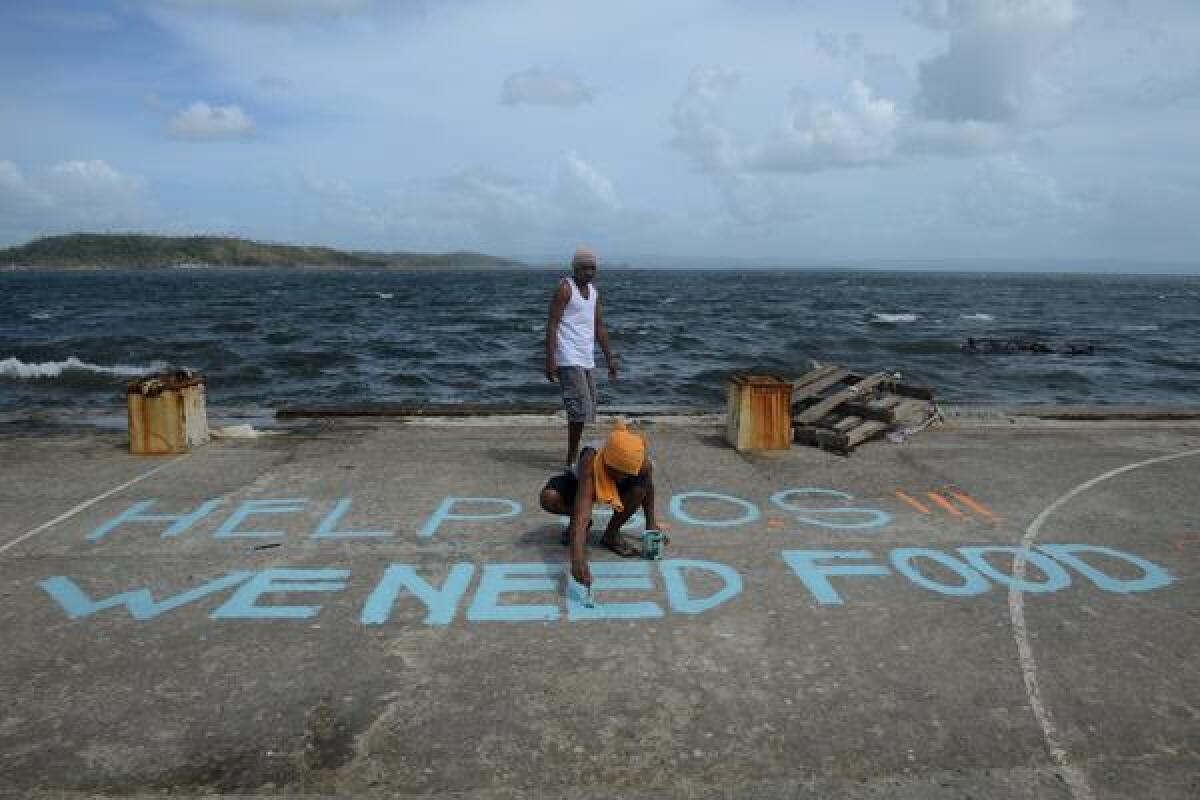Philippines typhoon leaves millions in need of food, water, shelter

- Share via
MANILA -- The scale of the devastation beginning to unfold in the wake of Typhoon Haiyan has stunned relief workers, who estimate that as many as 10 million people were affected by the storm that swept through the central Philippines late last week.
With many coastal areas still cut off from transportation and communications, government officials and relief workers were left guessing Monday as to the full impact of the storm, known as Yolanda by Filipinos.
“Right now we’re operating in a relative black hole of information,” Dr. Natasha Reyes, emergency coordinator in the Philippines for the international medical group Doctors Without Borders, said in a statement Monday. “We know from the very little we can see that the situation is terrible. But it’s what we don’t see that’s the most worrying.”
PHOTOS: Typhoon Haiyan slams Philippines
The official death toll, which stood at 1,774 Monday night, was expected to rise to 10,000 or more, according to officials and relief workers who surveyed the damage from the air.
Between 2 million and 3 million people were believed to have lost their homes, Joe Curry, Philippines representative for Catholic Relief Services, said in an interview. Millions more were left without access to adequate food, clean water or shelter.
“The numbers are just hard to comprehend,” he said.
“It’s turned a lush, tropical island into a wasteland,” Curry said of the island of Leyte, which was among the worst hit. “We’ve had so many typhoons before, but nothing compared to how intense and devastating this was.”
The most urgent needs include not just food and water, but tents and plastic sheeting, aid workers said.
“Imagine rural areas where people live in small villages, where everything is flattened, and there is debris everywhere,” Curry said. “They just need something over their heads to give them shade and give them a place to sleep at night, and right now they probably don’t have that.”
In a country with a long history of natural disasters, Haiyan could rank as the worst ever. President Benigno Aquino III has declared a “state of national calamity.” Relief trucks have been mobbed. Looting and jail breaks have also been reported in some areas.
GRAPHIC: The strongest typhoons
International aid agencies said they were rushing supplies and personnel to the region. Illustrating the extent of the need, the United Nations refugee agency, which usually focuses on conflict zones, said it was organizing an emergency airlift to the Philippines, sending basic items such as tents, plastic sheeting, blankets, mosquito nets, soap and underwear.
“The level of destruction we’re seeing reported is absolutely staggering,” U.N. High Commissioner for Refugees Antonio Guterres said in a statement.
Relief efforts so far are concentrated in Leyte’s devastated provincial capital, Tacloban, which has the largest airport in the region. Curry said it would take days to reach people in more far-flung areas.
“You need trucks. You have to distribute items, you have to do it in an orderly manner, and there’s concern that there’s not even functioning government right now,” he said.
Many medical facilities were damaged or destroyed, with much of their equipment washed away and health staff unaccounted for, said Reyes, of Doctors Without Borders.
The Philippines military is providing medical care from the Tacloban airport.
“People are bringing the injured to the airport from the town by motorbike or on foot; it’s a six-hour walk,” Reyes said. “Usually in these types of disasters, the main needs are related to people being displaced from their homes, and the injuries are relatively minor – cuts, broken bones, head wounds. But with so many houses and buildings having collapsed because of the strong winds, we’re expecting to see some significant injuries.”
Mental health needs are also expected to be significant.
“We’ve heard reports that people are walking around aimlessly, completely desperate,” Reyes said. “As a Filipino, I know that we’re a resilient people. We’ve been battered over and over again by natural disasters. So when I hear about people being so desperate, so stunned, so hopeless, it really tells me just how bad this is.”
ALSO:
Kerry: Nuclear talks fell apart because Iran balked
Palestinians mark anniversary of Arafat’s death, blame Israel
Key figure in Haqqani militant group is shot to death in Pakistan
Twitter: @alexzavis
De Leon reported from Manila and Zavis from Los Angeles.
More to Read
Sign up for Essential California
The most important California stories and recommendations in your inbox every morning.
You may occasionally receive promotional content from the Los Angeles Times.










